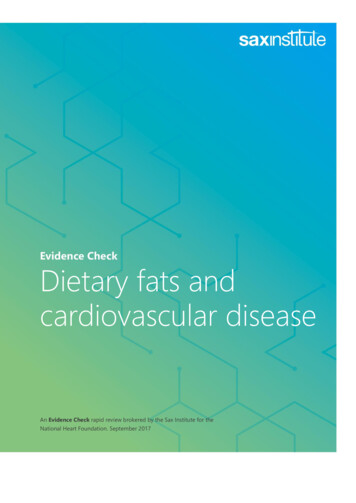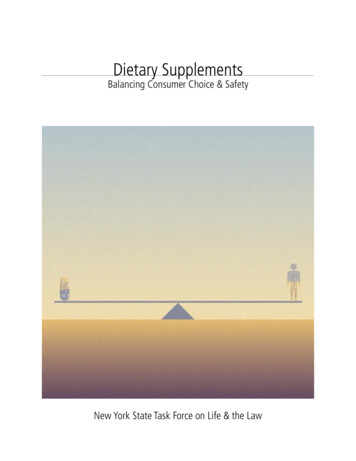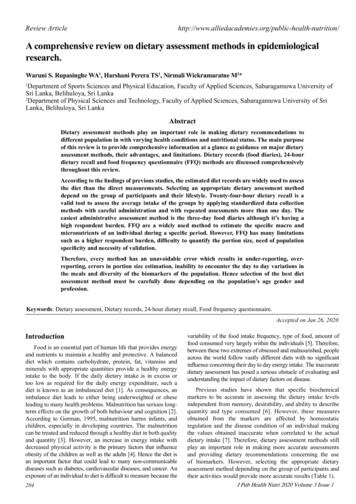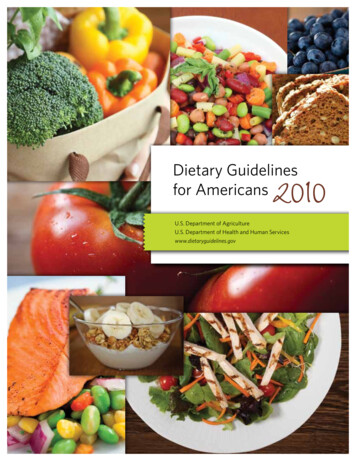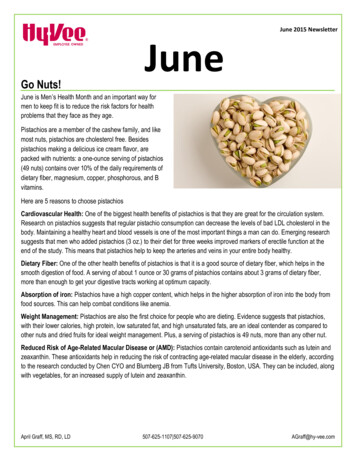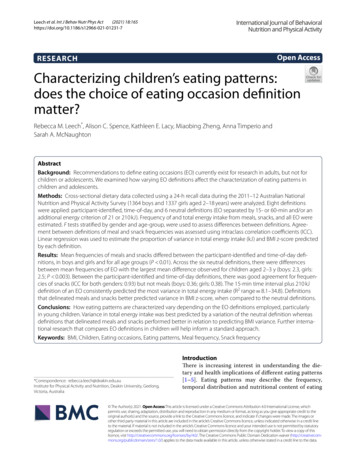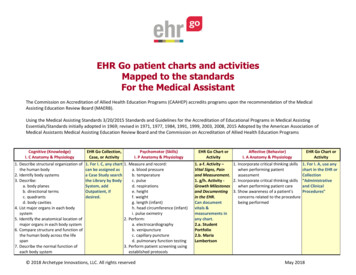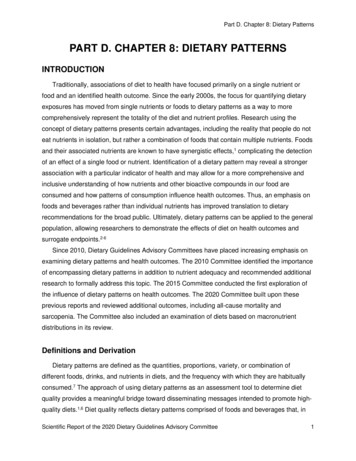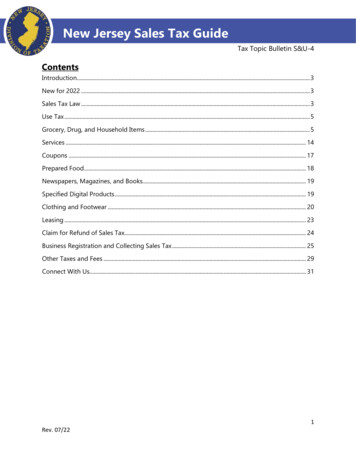
Transcription
nutrientsArticleA National Dietary Assessment Reference Database(NDARD) for the Dutch Population: Rationalebehind the DesignElske M. Brouwer-Brolsma, Martinette T. Streppel, Linde van Lee, Anouk Geelen,Diewertje Sluik ID , Anne M. van de Wiel, Jeanne H. M. de Vries, Pieter van ’t Veer andEdith J. M. Feskens *Division of Human Nutrition, Wageningen University, 6700 AA Wageningen, The Netherlands;elske.brouwer-brolsma@wur.nl (E.M.B.-B.); m.t.streppel@hva.nl (M.T.S.);Linde Van Lee@sics.a-star.edu.sg (L.v.L.); Anouk.geelen@wur.nl (A.G.); Diewertje.sluik@wur.nl (D.S.);anne.vandewiel@wur.nl (A.M.v.d.W.); Jeanne.devries@wur.nl (J.H.M.d.V.); Pieter.vantveer@wur.nl (P.v.V.)* Correspondence: edith.feskens@wur.nl; Tel.: 31-317482567Received: 1 September 2017; Accepted: 12 October 2017; Published: 18 October 2017Abstract: The development of reliable Food Frequency Questionnaires (FFQs) requires detailedinformation about the level and variation of dietary intake of the target population. However, thesedata are often limited. To facilitate the development of new high quality FFQs and validation ofexisting FFQs, we developed a comprehensive National Dietary Assessment Reference Database(NDARD) detailing information about the level and variation in dietary intake of people 20–70 yearsold in the general Dutch population. This paper describes the methods and characteristics of thepopulation included in the NDARD database. A total of 1063 men and 985 women agreed toparticipate in this study. Dietary intake data were collected using different FFQs, web-based andtelephone-based 24-h recalls, as well as blood and urine-based biomarkers. The baseline FFQ wascompleted by 1647 participants with a mean age of 51 12 years, BMI of 26 4 kg/m2 , and energyintake of 2051 605 kcal/day. The percentage of total energy intake from proteins, carbohydrates,and fats were 15 2, 43 6, and 36 5 En%, respectively. A total of 1113 participants completedtelephone-based recalls and 1783 participants completed web-based recalls. This database willenable researchers to validate existing national FFQs and to develop new high quality dietaryassessment methods.Keywords: dietary assessment; FFQ; recall; nutritional biomarker; validation1. IntroductionTo study the impact of diet on disease risk in observational studies, it is crucial to obtain validinformation about the habitual dietary intake of the population under study. Since food frequencyquestionnaires (FFQs) are relatively easy and inexpensive to process [1], large-scale epidemiologicalstudies generally use FFQs to rank participants according to their nutrient or food intake [1]. However,it is challenging to develop a valid and reliable FFQ.The first challenge in developing an FFQ is to accurately identify food items that contain thenutrients to be studied in the target population. In the Netherlands, researchers currently use theresults of the Dutch National Food Consumption Survey (DNFCS), compiled from a representativesample of the Dutch population [2], to identify relevant food items [3]. One of the drawbacks of usingthe DNFCS data is that they are collected by means of duplicate 24-h recalls [2] and thus providelimited information on the day-to-day variation in dietary intake. Therefore, the DNFCS data areNutrients 2017, 9, 1136; s
Nutrients 2017, 9, 11362 of 13considered to be insufficient to develop FFQs since it does not represent the actual large within-personday-to-day variation of nutrients such as vitamin A, vitamin C, and cholesterol [1].A second challenge arises when assessing the validity and reproducibility of the FFQ. FFQs areoften validated using other dietary assessment methods, such as 24-h recalls, as the reference method.One major drawback of this approach is that the results of the validation study may be biased bycorrelated errors such as memory, use of the same food composition tables, and/or use of standardportion sizes [4]. A biomarker of food intake is considered to be a more independent reference methodfor the validation of an FFQ since this method has fewer correlated errors. Unfortunately, foodbiomarkers are only available for a limited number of nutrients/foods. Urinary nitrogen, potassium,sodium, and doubly labelled water are examples of validated recovery markers/techniques that areused to estimate absolute intakes [5]. Carotenoids and n-3 fatty acids are validated markers to rankpeople according to their fruit/vegetable and fish intake [6,7].Ideally, FFQs should be validated for each nutrient under investigation. However, since validationstudies are cumbersome, costly, and inefficient, many of the nutrients studied by FFQs are not validated.In the absence of a validation study, misclassification of nutrient intake may remain unnoticed andresult in flawed conclusions with respect to potential diet–disease relationships. Thus, it is clear thatthe validation of a FFQ is very important and that the simplification of the validation process wouldgreatly benefit studies investigating the effect of diet on disease risk.We believe that a database containing extensive FFQ data, data from multiple 24-h recalls as wellas biomarkers, would provide the unique opportunity to perform validation studies on existing FFQsthat are cheaper and less time consuming than the validation studies that are currently conducted inthe context of individual studies. Moreover, such a database would also benefit the development andvalidation of new FFQs. Therefore, we initiated the National Dietary Assessment Reference Database(NDARD) project and developed a national database providing data on nutrient levels and variationsin habitual dietary intake as assessed by FFQs, multiple 24-h recalls, and biomarkers. This database can(1) serve as the foundation for the development of new dietary assessment methods; and (2) facilitatethe validation of existing and newly developed FFQs. With this manuscript, we aim to describe themethods used to collect the NDARD data and its population characteristics.2. Materials and Methods2.1. DesignThe NDARD database contains data from 2048 men and women aged 20 to 70 years collectedbetween May 2011 and February 2013, living in and around the city of Wageningen in the Netherlands.Municipality registries from Ede, Wageningen, Renkum, and Arnhem were used to select eligibleparticipants. In addition, all households in the city of Veenendaal received an invitation to participateas well. To be eligible, participants had to be able to speak and write Dutch. Those who wereinterested were asked to register online. Once registered, eligible participants were invited to thestudy center and randomly assigned to either the ‘FFQ group’ (n 959) or the ‘24-h recall group’(n 1089). All participants—i.e., participants in the ‘FFQ group’ and participants in the ‘24-h recallgroup’—completed a general 183-item FFQ. Thereafter, data collection in the ‘FFQ group’ focusedon the validation of an unconventional FFQ: the Flower FFQ. In the ‘24-h recall group’, dietary datacollection primarily focused on the collection of repeated telephone-based and web-based 24-h recalls.Along with the dietary intake assessment, participants underwent anthropometric measurements anda venipuncture, collected 24-h urine samples, and completed questionnaires related to their health andlifestyle. Measurements were repeated after 12 and 24 months (Table 1). All participants providedwritten informed consent before commencing the study. The study was approved by the ethicalcommittee of Wageningen University and conducted according to the declaration of Helsinki.
Nutrients 2017, 9, 11363 of 13Table 1. Overview of measurements of the National Dietary Assessment Reference Database(NDARD) project.MonthsMeasurementAll subjects (n 2048)AnthropometricmeasurementsBlood collection24-h urine collectionHealth FQ group (n 959)General FFQFlower basic FFQFlower special FFQ1Flower special FFQ2Flower special FFQ324-h recall (web based)Recall group (n 1089)General FFQ24-h phone based recall24-h web based xxxx3036xxxxxxxFFQ: food frequency questionnaire.2.2. Dietary Intake Assessment2.2.1. General FFQAll participants completed a 183-item semiquantitative general FFQ, which was designed shortlybefore the start of the study. This FFQ was designed to cover 96% of the absolute level of foodintake and 95% of the between-person variability of each nutrient under study as assessed inthe DNFCS from 1998 [8]. Commonly eaten manufactured food products that appeared on themarket later than 1998 were selected from the Dutch National Food Consumption Survey of 2011 andincluded in the FFQ as well. The reference period of the FFQ was the previous month. Participantsanswered questions relating to frequency by selecting answers ranging from ‘never’ to ‘6–7 days perweek’. Portion sizes were estimated using natural portions and commonly used household measures.Average daily nutrient intakes were calculated by multiplying the consumption frequency by theportion size and nutrient content in grams as indicated in the most recent Dutch food compositiontable (2011) [9]. Intake levels for energy, macronutrients, dietary fiber, and selected vitamins werevalidated [10–12]. The FFQ was self-administered and completed online (open-source survey toolLimeSurvey , LimeSurvey Project Team/Carsten Schmitz, Hamburg, Germany). Trained researchdieticians conducted several quality checks to ensure the quality of the FFQ.2.2.2. Flower FFQParticipants assigned to the FFQ group also completed a new type of FFQ, the Flower FFQ.The Flower FFQ was developed for the LifeLines Cohort Study [13] as an alternative to the regularFFQ, which is often a long and time-consuming questionnaire. The name Flower FFQ has been derivedfrom its design. The questionnaire consists of one basic questionnaire about energy and macronutrientintake (the heart of the flower) and three complementary food questionnaires concerning specific(micro)nutrients (flower petals). The basic FFQ contains 110 food items that are used to estimate theintakes of energy, fat, carbohydrates, protein, and alcohol. The first complementary FFQ (Flowerspecial FFQ1) contains 59 food items and is used to estimate the intake levels of different types of fattyacids as well as caffeine. The Flower special FFQ2 consists of 61 food items and is used to estimatethe intake levels of vitamin B2 , vitamin B6 , vitamin B11 , vitamin B12 , calcium, and soy. Lastly, the
Nutrients 2017, 9, 11364 of 13Flower special FFQ3 consists of 64 food items and is used to estimate the intake levels of vitamin A,vitamin C, vitamin E, and dietary fiber. Thus, the difference between the FFQs is in the degree ofdetail requested. For instance, the basic FFQ provides information on the amount of bread consumed,but does not contain questions about the type of bread consumed. More detailed information abouttypes of bread consumed—including fiber intake—has to be obtained from the flower special FFQ3,where the question “How many slices of bread do you eat?” is followed by questions on the type ofbread: white, whole grain, etc. To match the basic FFQ with the flower specials, the flower specials alsocontain the general questions that overlap with the basic questionnaire. In order to calculate the foodand nutrient intakes, information in the basic FFQ was assumed to be superior. More specifically, if afood was reported in the basic FFQ, but not in the flower special, a weighted average for the particularfood subgroups was assigned. If a food was not reported in the basic FFQ while it was reported inflower special, the food was recorded as not consumed. Combined, the four FFQs cover 96% of theabsolute nutrient intake and 93% of the between-person variability of each nutrient as assessed in theDNFCS from 1998. Participants answered questions on frequency by selecting answers ranging from‘never’ to ‘6–7 days per week’. Portion sizes were estimated using natural portions and commonlyused household measures. Average daily nutrient intakes were calculated by multiplying consumptionfrequency by portion size and nutrient content per gram as indicated in the Dutch food compositiontable from 2006 [14]. Although the reference period of the FFQs is one month, it is assumed that foodconsumption patterns are stable over a longer period of time. Therefore, the four flower FFQs can becompleted at different moments during a study period. In view of the validation studies within theNDARD-project all flower FFQs were administered three times (i.e., repeated after six and 12 months),which offers the opportunity to study reproducibility as well as seasonal influences. The Flower FFQwas administered online via the open-source survey tool LimeSurvey , Hamburg, Germany.2.2.3. Telephone-Based and Web-Based 24-h RecallsParticipants in the ‘recall-group’ were invited to complete nine 24-h recalls during a period ofone year, where the minimum period between the completion of two recalls was at least two weeks.Three of nine 24-h recalls were telephone-based and six recalls were web-based. The dates for eithertelephone-based or web-based 24-h recalls were randomly selected, scheduled regularly throughoutthe year, and proportionally evenly distributed over weekdays ( 70%) and weekend days ( 30%).The mode of administration, i.e., via telephone or internet, was also randomly selected. When recallattempts or electronic invitations were denied, the recall was randomly rescheduled within three to10 days. Telephone-based 24-h recalls were performed by trained dieticians using a standardizedprotocol and conducted using the five-step multiple pass method, which is a validated technique thatincreases the accuracy of recalls [15–18]. Portion sizes were assessed using commonly used householdmeasures, weight/volume, and standard portions. The recalls were transcribed into the food codes ofthe Dutch food composition table of 2011 [9].All dieticians participated in regular meetings to conduct quality checks to ensure the quality ofphone-based recalls and data encoding. Web-based recalls were self-administered using the softwareprogram Compl-eat (www.compleat.nl). Compl-eat was developed based on the five-step multiplepass method [15–18], which guided the participant through the process of reporting all foods anddrinks consumed during the previous day. The program enabled participants to select standard foodsand recipes that are commonly used in the Netherlands. If necessary, participants were able to adapt ordescribe personal recipes or to make notes for clarification. Portion sizes were reported in commonlyused household measures, standard portions, and weight in grams or volume in liters. Invitations tocomplete a 24-h recall were sent randomly via e-mail and valid for 24 h upon receipt. When participantsdid not respond within 24 h, the computer randomly generated a new invitation within 3–10 daysafter the first invitation. This process continued until the participant completed the recall. Nutrientand energy intakes were again calculated by multiplying intakes by nutrient composition using theDutch food composition database from 2011 [9].
Nutrients 2017, 9, 11365 of 13Furthermore, the intake of dietary supplements or the need to follow a particular diet, prescribedor otherwise, were registered. Participants also indicated where they ate their principal meals (location)and if they were eating alone or accompanied by others (companionship). Additional informationsuch as the need to follow a particular diet or the occurrence of special occasions such as birthdays orholidays were taken into consideration while checking the recalls. Participants were not contactedfor clarifications in case of potential errors in the dietary data. However, trained dieticians did checkall 24-h recalls for completeness, unusual portion sizes, and notes. Errors and notes were correctedaccording to a standardized approach using standard portion sizes and recipes. For instance, if aparticipant reported to consume 125 cups of coffee, this was corrected to 1 cup of 125 g.2.3. Anthropometric MeasurementsAnthropometric examinations were conducted by well-trained staff according to a standardizedprotocol. Height was measured, without shoes, with a stadiometer (SECA, Hamburg, Germany) tothe nearest 0.1 cm. Weight was measured, without shoes or sweaters and with empty pockets, on adigital scale (SECA, Hamburg, Germany) to the nearest 0.1 kg. Waist and hip circumferences weremeasured twice to the nearest 0.5 cm using a measuring tape (SECA 201, Hamburg, Germany) andsubsequently averaged. Waist circumference was measured midway between the lowest rib and thetop of the iliac crest at the end of gentle expiration. Hip circumference was measured around thewidest portion of the buttocks. During the anthropometric examination, information about medicationand nutritional supplement use was collected as well. The type of medication was classified accordingto the Anatomical Therapeutic Chemical classification system.2.4. Blood CollectionAfter a 10-h overnight fast participants underwent a venipuncture at the Gelderse Vallei hospitalin Ede or at the Rijnstate hospital in Velp. Biochemical analyses were performed in the hospitallaboratories using either a Dimension Vista 1500 automated analyzer (Siemens, Erlangen, Germany)or a Roche Modular P800 chemistry analyzer (Roche Diagnostics, Indianapolis, IN, USA). Bothlaboratories join the external quality control program in the Netherlands (SKML) and use the samemethodology and standardized protocols for risk factor assessments. Blood samples were used todetermine carotenoid and n-3 fatty acid concentrations, which can be used as a reference for rankingbased on fruit and vegetable intake [6] and fish intake [7]. The remaining plasma and serum sampleshave been stored at 80 C until further analysis is needed.2.5. Urine CollectionParticipants were asked to collect urine during one 24-h period each year. The day priorto the planned 24-h urine collection participants received verbal and written instructions, three80 mg para-aminobenzoic acid (PABA) tablets (PABAcheck, Elsie Widdowson Laboratory, Cambridge,UK), and two three-liter containers containing the preservative lithium dihydrogenphosphate (25 g).Urine collection started after the first voiding after waking up and finished after the first voidingafter waking up 24-h later. Participants were instructed to record the beginning and end times of theurine collection, the time at which the PABA tablets were ingested, their medication and nutritionalsupplement use, and any possible deviations from the protocol (e.g., missing urine). Urine containerswere delivered to the Gelderse Vallei hospital in Ede or the Rijnstate hospital in Velp and were storedat 4 C for a maximum of three days until they could be transported to the study center. At the studycenter, the urine collections of each participant were mixed, weighted, aliquoted, and stored at 20 Cuntil further analyses. PABA was used to check the completeness of the urinary collections and wasmeasured using the HPLC method [19]. PABA is assumed to be excreted almost quantitatively within24-h. Therefore, a recovery of at least 78% (189.6 mg) of the ingested PABA was considered to bea complete urine collection. The total coefficient of variation (CV) for the PABA analysis was 9%.The within-run CV for PABA was 1.9% and the between-run CV for PABA was 1.3%. Urinary sodium
Nutrients 2017, 9, 11366 of 13and potassium concentrations were measured with an ion-selective electrode on a Roche 917 analyzer(Roche Diagnostics, Indianapolis, IN, USA). Urinary creatinine concentrations were measured at520 nm on the Synchron LX20 by the modified Jaffé procedure using a commercial kit. Total 24-hsodium and potassium excretions were calculated by multiplying the total weight of the collected urineby the sodium or potassium concentration. Additionally, this was divided by 0.86 for sodium [20] andby 0.81 for potassium [21], assuming that this percentage of intake is excreted in the urine. The total24-h nitrogen excretion was determined by the Foss KjeltecTM 2300 analyzer [22]. The urinary nitrogenlevel was subsequently calculated using the following formula: 6.25x (urinary nitrogen/0.81) [23],which takes into account nitrogen loss via feces and skin (approximately 19%). Three 24-h 4.5 mL urinesamples have been stored at 20 C in the NDARD biobank for future analyses.2.6. Health and Lifestyle QuestionnairesHealth and lifestyle questionnaires were completed online using LimeSurvey , Hamburg,Germany. The questionnaires included questions about demographics (e.g., birth country, maritalstatus, household composition, and education), work history and current work situation, healthand history of diseases, and current and previous smoking habits (e.g., amount smoked, age atthe beginning and the end of smoking periods and the type of tobacco smoked as well as passivesmoking). Specifically for education, participants with no, primary, or lower vocational educationwere categorized as low educated. Participants with lower secondary or intermediate vocationaleducation were categorized as intermediate educated. Participants with higher secondary education,higher vocational education, or university were categorized as high educated. Regarding smoking, thecategory “never smokers” exists of participants who did not smoke during the past month and alsonever smoked for a full year. Thus, this category may include participants that smoke rarely, e.g., ata party. “Current smokers” smoked during the past month or at some point smoked for a full yearand did not stop smoking. “Former smokers” exists of those who at some point smoked for a fullyear, but did not smoke during the past month and stopped smoking. These general questions werepredominantly derived from LifeLines study questionnaires [13].Information about the habitual physical activity level was assessed using the Short Questionnaireto Assess Health-enhancing Physical Activity (SQUASH) and the Activity Questionnaire for Adults andAdolescents (AQuAA). The SQUASH contains separate questions about commuting activities, leisuretime activities, household activities, and activities at work and school covering three main queries:days per week, average time per day, and intensity. The total minutes of activity were calculated foreach question by multiplying frequency by duration. The activity scores for separate questions werecalculated by multiplying total minutes of activity by the intensity score. The total activity score wascalculated by taking the sum of the activity scores for separate questions [24]. The AQuAA is basedon the SQUASH questionnaire with the following adaptations: questions on light, moderate, andvigorous intensity activities as well as sedentary behaviors; questions about age-specific examples ofactivities; questions relating to activities performed in the previous seven days instead of an averageweek. The main outcomes are total physical activity score and the time spent on sedentary, light,moderate and vigorous intensity activities in minutes per week [25]. All questionnaires were repeatedafter 12 and 24 months.3. ResultsTable 2 displays the numbers and proportions of participants providing anthropometric data,blood samples, and urine samples. Moreover, the numbers and proportions of participants completingdemographic/lifestyle, health and dietary questionnaires are presented. Anthropometric data wereavailable of 2047 (100%) participants. In total 1881 (92%) participants provided blood and urine samples.Health and demographic/lifestyle questionnaires were completed by 1955 (95%) and 2038 (100%)participants, respectively. General FFQ data were available of 1647 (80%) participants. In the FFQgroup, 53 (0%) participants completed 1.1 0.2 (mean SD) telephone-based 24-h recalls and 832 (87%)
Nutrients 2017, 9, 11367 of 13participants completed 4.0 1.7 web-based 24-h recalls. Moreover, 772 (81%) participants completedthe basic FFQ of the flower FFQ, 709 (74%) completed the flower special FFQ1, 593 (62%) completed theflower special FFQ2, and 558 (58%) completed the flower special FFQ3. In the recall group, 1060 (97%)participants completed 3.8 1.5 telephone-based 24-h recalls and 951 (87%) participants completed6.2 2.6 web-based 24-h recalls.In Table 3, general characteristics of the NDARD population are shown. Men and women werefairly equally represented, 52% vs. 48%. On average, participants were 51 12 years of age, 63% wereclassified as having a high educational level, and 9% claimed to be current smokers. The mean BMIwas 26 4 kg/m2 , where the BMI for men was slightly higher than that for women.Table 4 displays the habitual dietary intake of the NDARD population and DNFCS population.The average energy intake can be broken down into total protein intake 15 2%, total carbohydrateintake 43 6%, total fat intake was 36 5%, and total dietary fiber intake 24 7 g per day. There wereno large differences in macronutrient intakes between men and women. However, men consumedmore alcohol, 15 15 g, than women, 7 9 g. Nine percent of the participants reported to follow aspecial diet (7% of the men and 12% of the women), and 41% reported nutritional supplement use(34% men, 49% women).
Nutrients 2017, 9, 11368 of 13Table 2. Sample sizes (n) of the data collected in view of the NDARD project.Complete data collection, n (%)Anthropometric measuresBlood samplesUrine samplesHealth questionnairesDemographic and lifestyle questionnairesGeneral FFQFlower basic FFQFlower special FFQ1Flower special FFQ2Flower special FFQ3Web based 24-h recallPhone-based 24-h recallAll(n 2048)Men(n 1063)Women(n 985)FFQ Group(n 959)Recall Group(n 1089)2047 (100)1881 (92)1881 (92)1955 (95)2038 (100)1647 (80)772 (38)709 (35)593 (29)558 (27)1783 (87)1113 (54)1062 (100)959 (90)959 (90)1005 (95)1060 (100)857 (81)404 (38)353 (33)296 (28)277 (26)920 (87)585 (55)985 (100)922 (94)922 (94)950 (96)978 (99)790 (80)368 (37)356 (36)297 (30)281 (29)863 (88)528 (54)959 (100)886 (92)883 (92)920 (96)954 (99)666 (69)772 (81)709 (74)593 (62)558 (58)832 (87)53 (0)1088 (100)995 (91)998 (92)1035 (95)1084 (100)981 (90)951 (87)1060 (97)Table 3. Comparison of the participant characteristics of the NDARD project (n 2048) and the Dutch National Food Consumption Survey (DNFCS) (n 2106).nAllMenWomenFFQ GroupRecall GroupDNFCS 19–69 Year *Men, %2048521000505350Age (years), mean (SD) **204551 (12)54 (12)49 (13)51 (13)52 (12)-Education level, 24523Area, 761601525521137401149-Smoking status, 253243BMI (kg/m2 ), mean (SD)204726 (4)27 (4)26 (5)26 (4)26 (4)26 (-)Waist (cm), mean (SD)204492 (13)97 (11)86 (12)92 (13)92 (13)-
Nutrients 2017, 9, 11369 of 13Table 3. Cont.nAllMenWomenFFQ GroupRecall GroupDNFCS 19–69 Year *Disease history, %Myocardial infarctionStrokeDiabetes -ALT (U/L), mean (SD)187927.0 (14.9)31.3 (15.2)22.5 (13.2)27.5 (16.4)26.5 (13.1)-AST (U/L), mean (SD)187822.8 (8.5)23.6 (8.7)21.9 (8.3)22.6 (9.2)23.0 (7.6)-GGT (U/L), mean (SD)188124.8 (25.2)29.7 (28.8)19.8 (19.6)24.8 (26.1)25.0 (24.2)-GFR (mL/min/1.73 m2 ), mean (SD)188189.9 (14.6)88.4 (14.3)91.2 (14.8)89.3 (14.1)90.3 (15.2)-* The DNFCS does not present data for the total group. Therefore, values are calculated using available subgroup data. Moreover, not all data is available in the DNFCS report, which isindicated by “-”. ** In the DNFCS only age ranges per subgroup are provided. ALT: Alanine aminotransferase; AST: Aspartate aminotransferase; GGT: Gamma-glutamyltransferase; GFR:Glomerular filtration rate.Table 4. Comparison of the dietary intake of the NDARD participants, as assessed with a general Food Frequency Questionnaires (FFQ), and the DNFCS.Dietary FactorNNDARDAllNDARDMenNDARDWomenNDARDFFQ GroupNDARDRecall GroupDNFCS Men31–50 Year *DNFCS Women31–50 Year *16478577906669813483512051 (605)2244 (631)1842 (499)2033 (623)2064 (593)2647 (2299–3022)1956 (1700–2227)Total protein (energy%), mean (SD)15 (2)15 (2)15 (2)15 (2)15 (2)15 (14–17)16 (14–17)Total carbohydrates (energy%), mean (SD)Mono- and disaccharides (energy%), mean (SD)Polysaccharides (% of energy), mean (SD)43 (6)19 (5)24 (5)43 (6)18 (5)25 (4)43 (6)20 (5)24 (5)43 (6)19 (5)24 (5)43 (6)19 (5)24 (5)43 (40–47)-45 (42–49)-Total fat, energy%Saturated fatty acids (energy%), mean (SD)Monounsaturated fatty acids (energy%), mean (SD)Polyunsaturated fatty acids (energy%), mean (SD)Trans fatty acids (energy%), mean (SD)36 (5)12 (3)13 (2)8 (2)0.6 (0.2)36 (5)12 (3)13 (2)8 (2)0.6 (0.2)36 (6)12 (3)13 (3)8 (2)0.5 (0.2)36 (5)12 (3)13 (2)8 (2)0.5 (0.2)36 (6)12 (3)13 (2)8 (2)0.6 (0.2)35 (32–37)13 (11–14)7 (6–8)1.5 (1.2–2.0)34 (31–37)13 (11–14)7 (6–8)1.2 (0.9–1.6)Alcohol (gram), mean (SD)11 (13)15 (15)7 (9)12 (14)11 (12)16 (6–29)4 (1–11)Dietary fiber (gram), mean (SD)24 (7)25 (8)23 (7)24 (8)24 (7)23 (19–27)18 (15–22)Total energy (kcal), mean (SD)Following diet regimen during the past month, %9712109919Nutritional supplement use, %41344938433654* The DNFCS does not display means but medians (25th–75th percentiles). In addition, in the DNFCS, data is presented by subgroups for age. In this table, intakes for men and womenaged 31–50 years are displayed.
Nutrients 2017, 9, 113610 of 134. DiscussionThe NDARD project is a four-year longitudinal study that collected an extensive body of dataon habitual dietary intake among 2048 Dutch adults living in and around the city of Wageningen inthe Netherlands. These data are meant to serve as the basis for the development of a national dietaryreference database that can be used
existing FFQs, we developed a comprehensive National Dietary Assessment Reference Database (NDARD) detailing information about the level and variation in dietary intake of people 20-70 years old in the general Dutch population. This paper describes the methods and characteristics of the population included in the NDARD database.
